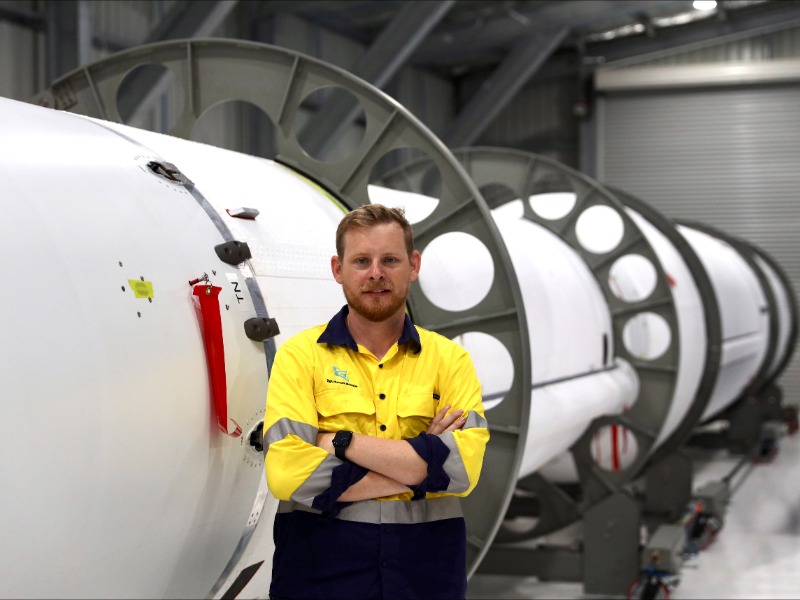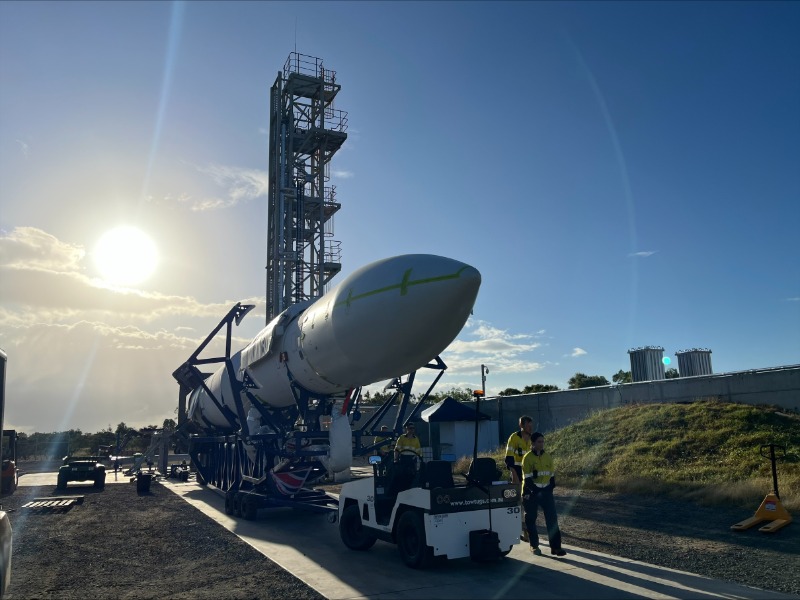The Gilmour Space Technologies team working toward Australia’s first sovereign orbital launch has “throttled-back” the pace of their work as the company waits on a final launch permit from the Australian Space Agency that will enable the maiden test flight.
Gilmour Space’ director of launch vehicles and satellites David Doyle told InnovationAus.com that the company had completed a series of dry tests but had made a deliberate decision to slow the pace of work toward launch so that it does not get too far ahead of the Australian Space Agency’s licences and permits process.
The slow-down has meant that the more complex ‘wet testing’ and launch dress rehearsals have been pushed back at least two weeks, and that the launch of Gilmour’s Eris orbital vehicle will not take place until June at the earliest.
Mr Doyle, an aeronautical engineer and former RAAF test pilot, said that slowing the work at the company’s Bowen Orbital Spaceport would put Gilmour’s preparation back in sync with the space agency – and would give the team a chance to rest so that they are ready to go for a final push.

The Eris test flight will be the first orbital launch from Australian soil in 50 years. It is Gilmour’s first orbital launch attempt, and the first sovereign Australian launch ever. It is the first time the Space Agency will have granted an orbital launch permit.
There is a lot to learn. David Doyle describes it as Gilmour pushing down a new path while the space agency simultaneously lays down the regulatory pavers.
There is no point in getting too far ahead of the regulatory process.
Once the permit is granted – and the Gilmour team is confident that it will – there could be a mandatory 30-day waiting or notification period before the launch can go ahead.
“From our perspective, we’ve slowed down a little bit. We’ve throttled back … to match the pace of the Space Agency [as they] continue to work on processing our Launch Permit application,” Mr Doyle told InnovationAus.com.
“We’re still working closely with the space agency and responding to queries that they’re sending us. But what we’ve seen is that our pace was out-matching theirs, and to manage those timelines so that we weren’t in a position where we were waiting for the agency and twiddling our thumbs, we have kind of throttled back a little bit,” he said.
Mr Doyle said the company was very confident about both the launch vehicle design and ground launch systems design, and that the team had been getting very good results from testing.
He says from the company’s perspective the time it is taking to obtain the permit “is not a matter of anything that is of concern,” but is rather a process of communicating the evidence and rationale for its high level of confidence.
The agency can then can satisfy itself that the launch vehicle is safe and effective, and that the company is operating safe and effective ground systems and launch processes.
“Looking at it from a from a leadership perspective, I just wanted to make sure that the team were bit more rested and ready to go. And we’re using this opportunity is to do that. That’s approach that we’ve taken.

Mr Doyle said putting the launch vehicle into its vertical position three weeks ago was a huge milestone. Psychologically it was important – everyone at Gilmour was elated – but from a practical perspective, moving the rocket to vertical involved solving a number of technical challenges.
The process of lifting the vehicle on to the transporter/erector, and then moving the erector into a vertical position put the rocket’s airframe under maximum stress – more stress than at any point in the process, including launch.
“So, in that sense, it’s already gone through its most critical environment in terms of the risk of damaging and breaking,” Mr Doyle said.
“That’s why it was such a significant milestone for us, because it was an area of key technical risk which we have now moved through,” he said.
“We are very, very comfortable with the rocket now. It was a great result. We were very closely monitoring the sensors on the vehicle and on the transporter/erector [through the process] and we saw really good results.
“There is more confidence now in terms of the engineering that has gone into it, and the design of the vehicle.”
The series of dry tests that the company has been doing lets it check out the vehicle and the ground launch systems and infrastructure. This includes the electrical and data networking systems that communicate with the Launch Control Centre (nine kilometres away) and the flight safety system used on the vehicle (enabling the abort processes).
The dry tests includes connecting all the ‘umbilicals’ – the hoses and electrical lines that connect to the vehicle at different points. The team has also been performing tests like switching over from ground power to internal battery systems.
This is a key step in the process and a key area of technical concern where a spike in the electrical supply could short-out or reset computers.
The team has started dry tests from the vehicle assembly building with the rocket in a horizontal position, with a “dark cockpit” – meaning the vehicle is unpowered.
They then go through the entire process of powering the vehicles, checking its systems and subsystems, rolling it out to the tower and putting it to vertical and then carry out all of the tests it would do in the lead up to launch, including all communications with the Launch Control Centre.
The same people who will be working in the vehicle control building on launch day are working in the vehicle control building during these tests. Each is a rehearsal. The same for the Launch Control Centre; the team members who will operate the centre on launch day are in the centre during dry tests.
Mr Doyle says that once the team has performed the full dry tests a half-dozen times, it will start to become routine. And, assuming the dry testing has gone well, the company will move to the final stage of “wet testing” – where propellants are pumped aboard the craft for the first time.
The wet tests will mark the next significant milestone on its march toward launch. Mr Doyle says the company’s new schedule puts wet testing in mid-May.







